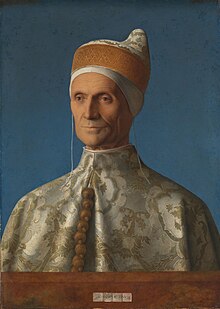
Back ليوناردو لوريدان Arabic ليوناردو لوريدان ARZ Леонардо Лоредано Bulgarian Leonardo Loredan German Λεονάρντο Λορεντάν Greek Leonardo Loredan Esperanto Leonardo Loredan Spanish Leonardo Loredan French לאונרדו לורדאן HE Leonardo Loredan Croatian
| Leonardo Loredan | |
|---|---|
 | |
| Doge of Venice | |
| Reign | 13 October 1501 – 22 June 1521 |
| Coronation | 13 October 1501 |
| Predecessor | Agostino Barbarigo |
| Successor | Antonio Grimani |
| Born | 16 November 1436 Venice, |
| Died | 22 June 1521 (aged 84) Venice, |
| Burial | 23 June 1521 |
| Spouse |
Morosina Giustiniani di S. Moisè
(m. 1461; died 1500) |
| Issue | Lorenzo, Girolamo, Alvise, Vincenzo, Bernardo, Donata, Maria, Paola, Elisabetta |
| Dynasty | House of Loredan |
| Father | Gerolamo Loredan di S. Vitale |
| Mother | Donata Donà di Natale |
| Religion | Roman Catholicism |
| Signature | |
Leonardo Loredan (Italian: [leoˈnardo loreˈdan]; Venetian: Lunardo Loredan [luˈnaɾdo loɾeˈdaŋ]; 16 November 1436 – 22 June 1521) was a Venetian nobleman and statesman who reigned as the 75th Doge of Venice from 1501 until his death in 1521. As a wartime ruler, he was one of the most important doges in the history of Venice. In the dramatic events of the early 16th century, Loredan's Machiavellian plots and cunning political manoeuvres against the League of Cambrai, the Ottomans, the Mamluks, the Pope, the Republic of Genoa, the Holy Roman Empire, the French, the Egyptians and the Portuguese saved Venice from downfall.
Born into the noble Loredan family in 1436, Leonardo dedicated his youth to classical education, after which he focused on trade in Africa and the Levant, in line with family tradition. Legend has it that in Africa a fortune-teller predicted for him the future of a prince in his homeland. In 1461 he married Morosina Giustiniani, whose influential family, according to some historians, played a significant role in his election as Doge later on.
He began his political ascent as a lawyer in a legal magistracy concerned mainly with financial scandals and bankruptcies, which he followed with an illustrious career that included positions such as Sage of the College, Sage of the Terraferma, Camerlengo di Comùn, Podestà of Padua, ducal councillor for Cannaregio, and finally Procurator of Saint Mark, one of the highest and most distinguished offices in the Venetian Republic, which allowed him to rise to the political top of the state. In October 1501, he was elected the 75th Doge of Venice.
Loredan's reign began during the disastrous Second Ottoman–Venetian War, which he settled with a peace treaty in 1503 at the cost of considerable loss of territory. Later that year a dispute arose between Loredan and Pope Julius II, after Venice occupied territory in the northern Papal States. This escalated into the 1509 War of the League of Cambrai, in which Venice was fighting an alliance of the Pope and France. Venice was defeated, but in 1513 Loredan formed a new alliance with the French King Louis XII against Pope Julius. This resulted in a decisive victory.
It was under his rule, in 1516, that a decree was enacted to formally isolate the Jews of Venice. Thus was created the first “Ghetto” in the world, from which all others derive their name.
Despite his last years being laden with financial and political scandals, some artfully mounted by rival families, Loredan died with great fame in June 1521 and was interred in the Basilica of Saints John and Paul, in a simple grave which no longer exists. In 1572, a monumental tomb was erected for him in the Basilica, adorned with Corinthian columns made of Carrara marble, which included work by architects and sculptors Girolamo Grappiglia, Girolamo Campagna and Danese Cattaneo.
Loredan was portrayed in numerous portraits and paintings, the most famous of which being the Portrait of Doge Leonardo Loredan, painted by Giovanni Bellini in 1501 and now on display in the National Gallery in London. In 1507, Bellini painted Loredan with his four sons in the Portrait of the Loredan family, now on display at the Gemäldegalerie in Berlin. Loredan was also notably portrayed by Vittore Carpaccio, and posthumously by Pompeo Batoni in a work known as The Triumph of Venice (1737), where he is depicted in front of the Doge's Palace surrounded by mythological figures symbolising his victory over the League of Cambrai. In 1503, the Panegyricus Leonardo Lauredano was created in his honour.